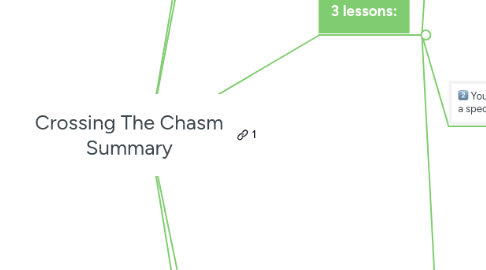
1. 1-Sentence-Summary:
1.1. Crossing The Chasm gives high tech startups a marketing blueprint, in order to make their product get the initial traction it needs to eventually reach the majority of the market and not die in the chasm between early adopters and pragmatists.
2. Favorite quote from the author:
2.1. "Entering the mainstream market is an act of burglary, or breaking and entering, of deception, often even of stealth." - Geoffrey A. Moore
3. 3 lessons:
3.1. The chasm is a gap between visionary early adopters and the pragmatic majority.
3.1.1. The main idea of the book is based on the technology adoption life cycle
3.1.1.1. It states that new technology makes its way through the population in a bell curve distribution.
3.1.2. Innovators jump on the product at first, followed by early adopters, the early and late majority, to finally reach the laggards (the people who only got a Facebook account when their Mum had already joined 6 months before).
3.1.3. The chasm is the huge gap that lies between the early adopters and the early majority, when a product is very disruptive and requires behavioral changes.
3.1.4. The reason is that the motivations for buying a product are vastly different.
3.1.4.1. The visionary early adopters want huge changes and are willing to bet on them against the odds.
3.1.4.2. People in the early majority are much more pragmatic though. They don’t want big changes and huge innovations, but rather incremental improvements based on using proven products and solutions.
3.1.5. Therefore, most arguments visionaries make to get the majority to buy aren’t appealing.
3.1.6. The majority wants to buy from established brands and companies, but without having the majority buy your product, you can’t become an established brand.
3.1.7. This dilemma is what Geoffrey Moore calls “The Chasm” and it’s something all high tech companies must overcome, if they ever want to see their product become successful and reach the majority of the population.
3.2. You can only cross the chasm by targeting a specific niche first.
3.2.1. To overcome the chasm, pick a very targeted and specific niche of customers inside the early majority to focus on. Then you can expand into other niches later on until you cross the critical threshold.
3.2.1.1. Think of it as first securing a beachhead in an invasion, to take a stand and then build from there.
3.2.1.2. In order to convince your target segment you’re selling a holistic, well-supported product with good references and establish yourself as the market leader, you have to strictly sell to only your target group.
3.2.2. Don’t expand too early or sell to outsiders, just because you have the chance to.
3.2.2.1. You’ll end up adjusting and customizing your product to death to make it fit for every individual purchase.
3.2.3. When you commit to only sell to 28-34 year old professionals in San Francisco, for example, you gain 3 advantages:
3.2.3.1. Since the market is small, it’s easier to win over the majority in it.
3.2.3.2. Word of mouth references circulate faster.
3.2.3.3. You can develop a standard package product that meets all requirements of your target group.
3.3. Position yourself as the market leader in your niche by making a strong claim.
3.3.1. When you hear the word Lamborghini, you immediately recall certain attributes in your head, like “expensive”, “luxurious”, “high-end”, “sportscars” and “rare”.
3.3.1.1. That’s great positioning in action.
3.3.2. Pragmatists want to know where you stand with respect to your competition (as they’re only interested in established brands), but you’re the high tech newbie, and there might not even be direct competition, so what can you do?
3.3.2.1. You define your competition yourself.
3.3.2.2. When you contrast yourself with a market alternative (the traditional way of doing things) and a product alternative (a competitor, who uses the same technology, but in a different industry), you can easily position yourself as the leader in the new, combined field.
3.3.3. For example, Dropbox could’ve positioned itself by saying: “For private PC users, who are sick of carrying files from one PC to the next via USB stick, we offer a hardware-free file syncing solution. Our service makes your files available on any device with an internet connection, just like YouTube does with video, but with any type of file you choose.”
3.3.3.1. These 2 sentences are all it takes to give you a powerful position – in fact, it shouldn’t take more than 2 sentences to make it clear to everyone in your target niche.
3.3.4. This claim will allow you to focus exactly on your initial niche and eventually take the majority of the market share there, so you can then expand and dominate the rest of the market as well.
